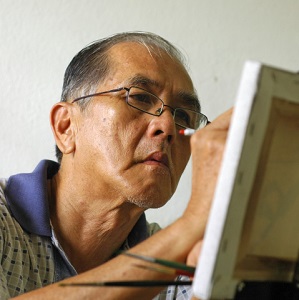The Benefits of Expressive Arts Therapy

This article will explore five common benefits associated with the use of expressive arts therapy:
- Expressive arts therapy encourages the unfolding unconscious. When working with expressive media, people often benefit from the unconscious bubbling to the surface of their awareness. Various media like painting, psychodrama, dance, and sculpting draw forth unearthed material that may not have been seen, felt, observed, or accessed in some way via talk therapy. Through letting go and getting into the creative flow, a portal is created to the process, enabling listening, watching, and observing what might not be explained through words. An example of this would be a person viewing an image and recalling a buried memory shaping their current experience. Another example would be a therapist suggesting to a person that mask-making might deepen the process of a new sub-personality. Whether the choice is a specific media (i.e. paint or sculpture) or the person’s own media (i.e. voice and movement), the process of unfolding to the unconscious material is supported as the person allows the new material to emerge.
- It informs communication between a person and their therapist. Another benefit that makes expressive arts therapy inviting is the increased depth of spoken and unspoken communication which results from the expression process and the product itself. The process makes way for additional communication to be made known, which may inform the person and his/her therapist of new insights. An example of this might be when the process of creating an authentic movement piece stirs additional emotion within a person’s experience, resulting in a dialogue about the new feelings that have emerged. The product can also increase or enhance the meaning, infuse additional unseen material, and provide an externalized venue for further discussion. An example of this would be a therapist supporting a person in expressing his or her grief by tapping into his or her talent as a watercolor artist and creating an abstract of his or her grief. The therapist could inquire about the use of color, line, and symbols present in the art.
- Expressive arts therapy externalizes and gives form to unfolding material. Giving process a physical form allows a person to feel in control of their process. It can bring depth and life to feelings and images. It shines light on ambivalent feelings by externalizing them and giving them shape and color. One example is having a person draw an image of how they are currently feeling. Doing this might elicit additional information that wasn’t available to the person cognitively. Additionally, one of the benefits is externalizing the process so that a person can witness and be an observer of their own process. This is especially helpful for painful and difficult images and memories by allowing the a person to observe things from a distance. An example of this would be to have the person talk and explain their experience as if they are watching a movie. This allows them to psychically remove him or herself from the painful somatic response that might be risky in the moment.
- It awakens and sparks process. Probably the most obvious benefit of expressive arts therapy is the spark created in the imagination. This awakening process allows the person to experience something new. It’s like an a-ha moment, a new discovery. It can lead to new things, bring light to something stuck, open a new doorway to unarticulated feelings, and shed light on the past. It can provide a new language and foster existing language when current circumstances and words cannot describe the unfolding process.
- Expressive arts therapy supports integrative learning. It encourages the undiscovered places of knowledge within each person. The opportunity for a person to experience a different way of knowing is enhanced by different sensory experiences. Each experience is enhanced by the other and forms new experiences, thoughts, sensations, and images not normally experienced in the person’s normal one-dimensional experience. As a result, a rich tapestry takes form. An example of this might be asking a person to explore sounds representative of their current experience, which then deepens into the depth of pain that had gone unnoticed.
As you can see, there are many deepening and enriching experiences that expressive arts therapy supports to create a richer, more vibrant therapeutic experience. Each modality is unique, as is each therapist’s use of the modality and the client’s comfort with the material. The beauty is in the process and not the product, which is at the heart of all therapy.
© Copyright 2007 - 2025 GoodTherapy.org. All rights reserved.The preceding article was solely written by the author named above. Any views and opinions expressed are not necessarily shared by GoodTherapy.org.